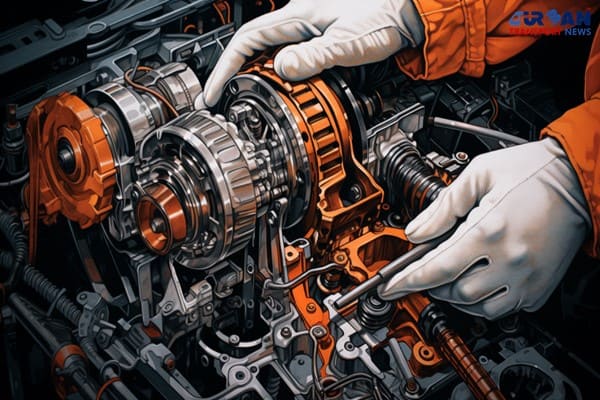 Delhi unveils ambitious Urban Mobility Vision: Luxury Metro Coaches, New Tunnels and Pod Taxi
Delhi unveils ambitious Urban Mobility Vision: Luxury Metro Coaches, New Tunnels and Pod Taxi Qatar approves Saudi Rail Link Agreement, Accelerating Gulf Railway Vision 2030
Qatar approves Saudi Rail Link Agreement, Accelerating Gulf Railway Vision 2030 UP Govt plans to introduce Water Metro services in Ayodhya, Varanasi & Prayagraj
UP Govt plans to introduce Water Metro services in Ayodhya, Varanasi & Prayagraj India’s First Urban Ropeway begins Trial Run in Varanasi, Set to carry 1 Lakh passengers daily
India’s First Urban Ropeway begins Trial Run in Varanasi, Set to carry 1 Lakh passengers daily India and Bhutan to Build First-Ever Rail Link: ₹4,033 Cr Project to Boost Regional Connectivity
India and Bhutan to Build First-Ever Rail Link: ₹4,033 Cr Project to Boost Regional Connectivity Patna to launch Eco-Friendly Water Metro; Trial Run soon between Digha and Kangan Ghats
Patna to launch Eco-Friendly Water Metro; Trial Run soon between Digha and Kangan Ghats Air India Group set to launch Flights Operations from Navi Mumbai International Airport
Air India Group set to launch Flights Operations from Navi Mumbai International Airport Chennai to launch 25-Year Mobility Plan with Unified QR Ticketing and One-App Transit System
Chennai to launch 25-Year Mobility Plan with Unified QR Ticketing and One-App Transit System Kochi Metro bags ₹4.4 crore contract to prepare DPR for Mumbai Water Metro Proejct
Kochi Metro bags ₹4.4 crore contract to prepare DPR for Mumbai Water Metro Proejct Navi Mumbai International Airport set for September launch; IndiGo and Akasa Air to lead Operations
Navi Mumbai International Airport set for September launch; IndiGo and Akasa Air to lead Operations
Behind the Gears: Unpacking Car Transmission Repairs

Imagine you're a surgeon, your patient: your car's transmission. It's the heart of your vehicle, and it's in trouble. You've noticed symptoms, strange noises, odd behavior.
Don't panic! In 'Behind the Gears: Unpacking Car Transmission Repairs', we'll guide you through diagnosing and fixing common transmission problems. You'll also learn how to prevent issues before they start.
It's your vehicle; you're in control. Let's dive in.
Understanding the Role of Car Transmissions
In understanding the role of car transmissions, you're delving into the heart of how your car functions, converting engine power into movement. You've possibly heard the term 'transmission' thrown around by auto enthusiasts or mechanics, but do you really know what it means? Let's break it down.
A car transmission is a complex system that uses gears and gear trains to provide speed and torque conversions from a rotating power source (the engine) to another device (the wheels). You're essentially taking the raw power generated by your car's engine and translating it into controlled speed and torque. When you shift gears, you're telling the transmission precisely how much power to send to your wheels.
If your transmission isn't working correctly, you'll notice. You might experience a grinding noise, difficulty shifting gears, or even a noticeable delay before your car begins to move. These are all signs you may need a repair or replacement. Understanding this crucial component of your vehicle can help you to identify potential issues early and seek out professional help when necessary.
Common Problems and Symptoms in Car Transmissions
You're likely to run into a few common problems with your car's transmission, but by being aware of the symptoms, you can tackle these issues head on. For instance, if you're experiencing delayed engagement, where the vehicle hesitates before shifting into gear, it's a clear sign your transmission could be in trouble. This often manifests as a pause when you shift from park to drive.
Another common issue is transmission slipping. You might notice your car changing gears for no apparent reason, or you may hear whining or unusual noises. In severe cases, your car might even feel like it's struggling to accelerate.
Leaks are another telltale sign to watch out for. Your transmission needs fluid to function properly, and if you spot bright red, sweet-smelling fluid under your car, it's likely you've got a leak.
Lastly, if your transmission warning light comes on, don't ignore it. This could indicate anything from low fluid levels to severe damage.
Understanding these common transmission problems and their symptoms allows you to act quickly and prevent further damage. If you happen to face these issues and are in Dubai, consider seeking expert assistance for car transmission repair in Dubai. Now that you've got a handle on these, let's move on to the process of diagnosing transmission issues.
The Process of Diagnosing Transmission Issues
When you're dealing with a potential transmission problem, the first step is diagnosing the issue, and that often involves a series of tests or inspections. Navigating this technical terrain can be daunting, but you're about to learn the ropes.
- Visual Inspection: Look for visible signs of damage, leaks, or wear. Any unusual discoloration or metal shavings in the transmission fluid is a red flag.
- Road Test: Test-drive the vehicle to observe any irregularities. Listen for any noises, feel for any vibrations, and pay attention to how smoothly the car shifts gears.
- Computer Diagnostics: Most modern cars come equipped with a computer that can provide error codes and other diagnostic data. A special scanning tool is used to read this information, which can help pinpoint the issue.
This process may seem complex, but it's the most effective way to diagnose transmission problems. Remember, the sooner you identify and address the issue, the less damage your transmission will suffer.
Take note of what you've learned here, it'll come handy when you're faced with transmission troubles. Next, we're delving deeper as we explore 'inside the transmission repair: a step-by-step guide'.
Inside the Transmission Repair: A Step-by-Step Guide
Armed with knowledge from diagnosing transmission issues, you'll now dive into the heart of the matter, focusing on the nitty-gritty details of transmission repair, a process both intricate and crucial.
First, you'll need to drain the transmission fluid. It's a messy job, but it's an essential step that can't be skipped. Once the fluid is drained, you'll remove the pan and filter, examining them for debris that might indicate more serious issues.
Next, you'll disassemble the transmission. You'll remove the valve body and clutch packs, inspecting each component for wear and damage. Be meticulous here; even a small issue can lead to big problems down the road.
After inspection, it's time to replace any faulty parts. You'll need to carefully reassemble the transmission, ensuring each piece fits perfectly. Remember, precision is key. Lastly, you'll refill the transmission with fluid, keeping an eye on the level to avoid overfilling.
Lastly, you'll test the transmission to ensure it's functioning properly. It's a detailed process, but with patience and attention to detail, you'll be able to successfully navigate through the complexities of transmission repair.
Preventive Measures and Maintenance Tips for Transmissions
Keeping your car's transmission in optimal condition isn't just about repairs; it's also about regular maintenance and taking preventive measures. You can avoid costly repairs and prolong the lifespan of your transmission by adhering to a few simple guidelines.
Here are three easy-to-follow tips to keep your transmission in its best shape:
- Regular Fluid Checks: Transmission fluid acts as a lubricant for the gears. Check the fluid levels regularly and ensure it's clean and not burnt. If it's dirty or has a burnt smell, you need to change it.
- Avoid Overloading: Your vehicle's transmission is designed to handle a specific load. Overloading your car can strain the transmission, leading to premature wear and tear. Be mindful of your vehicle's load capacity.
- Timely Servicing: Never overlook the importance of regular servicing. It helps in identifying potential issues before they become major problems. Make sure you're getting your transmission inspected by a professional during each service.
In the long run, taking preventive measures and performing regular maintenance can save you a lot of money and trouble. Remember, it's always cheaper to maintain than to repair. So, take good care of your transmission - your car's performance depends on it.
Conclusion
Did you know that nearly 13% of all car troubles are related to the transmission? That's a significant number!
So, don't ignore the signs. If you're experiencing any transmission issues, get it diagnosed and repaired promptly. Remember, regular maintenance is key to preventing major repairs in the future.
Your car's transmission plays a vital role – treat it with the care it deserves.







